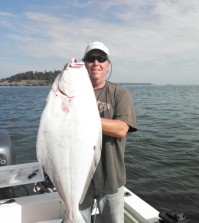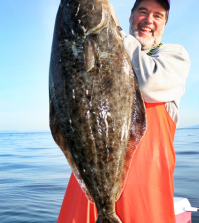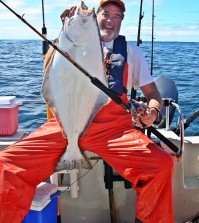Westport Halibut Recap
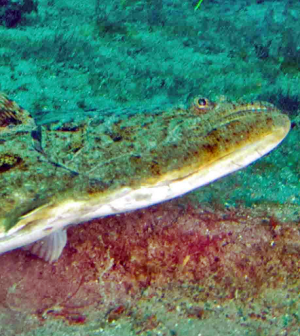
Earl Sande of the Kitsap Poggie Club provides this expedition report of his May 1 halibut excursion to Westport, along with a caution for anglers to conserve this fishery by releasing any large females they hook.
Bad weather and extreme tides always make halibut fishing in the ocean difficult, but this year on the three days we were fishing it was decent on both counts.
We had moorage for three days of fishing. The first day we planned to go out about 15 miles in 180 feet of water for halibut and with a little luck we did manage to put a 30 and 40 pounder in the fish box along with a lingcod and a few nice sea bass.
The following day the deep water halibut was closed, but the near shore area to the north was open so we went north about 20 miles in 120 feet of water and put 12 sea bass and a lingcod in the fish box.
We spent the afternoon filleting our harvest and cleaning up the boat plus having a big fish fry for dinner. The third day, a Tuesday, we headed back out to where we fished on Sunday and luckily put two halibut, a 45 and a 20-pounder, in the fish box.
The fishing was pretty slow out there that day with quite a few guys on the radio complaining. But we were very happy with our three days catch and headed for home thinking about how the July 1 Chinook opener will pan out at Westport!
It’s hard to believe, but Pacific halibut were once caught in Hood Canal. Early in the last century, the area around Seabeck was fairly good fishing for halibut during spring and summer. A few years ago a woman told me her dad caught a large halibut near Bremerton off the Navy Yard during the early days of World War II.
By 1890 the commercial halibut fishery was going full bore off the Washington Coast. Within 10 years these halibut grounds were getting depleted and most of the fleet headed to British Columbia and Alaska. By 1920 the halibut fishery on the entire West Coast was headed for a complete disaster. We were simply too good at catching halibut. Once again over-fishing was rearing its ugly head. Fortunately, just before the Pacific Halibut became so depleted that it was no longer profitable to fish for them, the United States and Canada ratified the Northern Pacific Halibut Treaty on October 21, 1924. This treaty was placed in the hands of an international commission to obtain facts about halibut and in 1931 this commission was given the power to regulate halibut harvest from Alaska to California. With more controlled commercial fishing, halibut stocks slowly began to increase and by the 1950s they were doing much better.
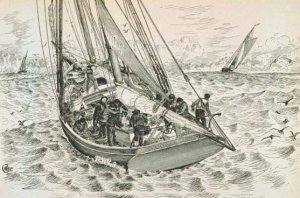
a halibut schooner, c. 1890
Halibut belong to a family of flounders called Plueronectidea. Pacific halibut can be found from southern California to the Bering Sea to the coast of Japan. They live from near shore to over the edge of the continental shelf and have been recorded at depths of 3,600 feet. Most though, are caught at depths between 60 and 800 feet.
Halibut spawning takes place during winter, peaking in December and February. Most of the spawning takes place near the edge of the continental shelf in waters up to 1,500 deep. Male halibut become sexually mature at about eight years old and females about 12. Males can live to be nearly 30 years old and females can live to be almost 50. Nearly all halibut over 100 pounds are female with some reaching 500 pounds. A 700 pounder was reported caught off the east coast of Russia a few years ago and I saw a picture of an 800-pounder caught in Alaska in 1977. Some people think that somewhere out there swims a 1,000-pounder!
A 50-pound female can produce 500,000 eggs, whereas a 250-pounder can produce four million eggs. The large females really should not be harvested if we want halibut in our future. As the eggs develop into larvae and grow, they slowly drift upward in the water column from the great depths below. During this development time period, the larvae may drift many hundreds of miles with the ocean currents in a counter-clockwise direction around the North Pacific Ocean. Usually by the time they have reached near shore they have evolved into little fish, first swimming on edge, then at about one-inch long they slowly rotate to their side. At about that same time, the left eye slowly moves over next to the right eye. At six months of age they look like a halibut only in miniature.
Halibut feed in near shore waters for about three years and are about one-foot long at this time. Then they begin to migrate to the south for the next five to eight years, eventually getting closer to where their parents lived as mature adults. But sometimes halibut will just keep swimming looking for food for hundreds, even thousands of miles. One tagged in the Bering Sea was caught off the coast of Oregon, a journey of nearly 2,000 miles.
Older halibut tend to migrate less. During those retirement years some seem to come closer to shore to feed in the summer and then head to deeper water in the winter to spawn.
A 22-incher weighs about four pounds; a 40-incher about 30 pounds; a 60-incher about 110 pounds; an 80-inchers about 290 pounds; and a 100-incher is a whopping 570 pounds!
Large halibut are strong swimmers and hungry carnivorous feeders. A seven-inch crab can easily be swallowed whole. Their diet includes cod, sablefish, Pollock, rockfish, sculpins, other flatfish, sandlance, herring, octopus, clams, smaller halibut and just about anything else dead or alive.
Halibut have a lot of nutritional value with lots of vitamins, amino acids, minerals and trace elements like selenium, and are high in healthy fatty acids.
Fresh halibut is for sure one of the tastiest foods on earth!


